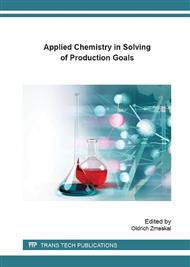[1]
J. Jancar, J.F. Douglas, F.W. Starr, S.K. Kumar, P. Cassagnau, A.J. Lesser, S.S. Sternstein, M.J. Buehler, Current issues in research on structure–property relationships in polymer nanocomposites, Polymer 51 (2010) 3321–3343.
DOI: 10.1016/j.polymer.2010.04.074
Google Scholar
[2]
E.T. Kopesky, T.S. Haddad, G.H. McKinley, R.E. Cohen, Miscibility and viscoelastic properties of acrylic polyhedral oligomeric silsesquioxane–poly(methyl methacrylate) blends, Polymer 46 (2005) 46.
DOI: 10.1016/j.polymer.2005.04.001
Google Scholar
[3]
H.J. Hassabandi, M. Wilhelm, A rheological criterion to determine the percolation threshold in polymer nano-composites, Rheol. Acta 53 (2014) 869–882.
DOI: 10.1007/s00397-014-0804-0
Google Scholar
[4]
J.B. Hooper, K.S. Schweizer, Theory of Phase Separation in Polymer Nanocomposites, Macromolecules 39 (2006) 5133–5142.
DOI: 10.1021/ma060577m
Google Scholar
[5]
A. Aggeli, I.A. Nyrkova, M. Bell, R. Harding, L. Carrick, T.C.B. McLeish, A.N. Semenov, N. Boden, Hierarchical self-assembly of chiral rod-like molecules as a model for peptide b-sheet tapes, ribbons, fibrils, and fibers, Proc. Natl. Acad. Sci. U. S. A. 98 (2001).
DOI: 10.1073/pnas.191250198
Google Scholar
[6]
S.H. Phillips, T.S. Haddad, S.J. Tomczak, Developments in nanoscience: polyhedral oligomeric silsesquioxane (POSS)-polymers, Curr. Opin. Solid State Mater. Sci. 8 (2004) 21-29.
DOI: 10.21236/ada422636
Google Scholar
[7]
R. Misra, A.H. Alidedeoglu, W.L. Jarrett, S.E. Morgan, Molecular miscibility and chain dynamics in POSS/polystyrene blends: Control of POSS preferential dispersion states, Polymer 50 (2009) 2906-2918.
DOI: 10.1016/j.polymer.2009.03.057
Google Scholar
[8]
M. Sanchez-Soto, D.A. Schiraldi, S. Illescas, Study of the morphology and properties of melt-mixed polycarbonate-POSS nanocomposites, Eur. Polym. J. 45 (2009) 341-352.
DOI: 10.1016/j.eurpolymj.2008.10.026
Google Scholar
[9]
A. Fina, D. Tabuani, A. Frache, G. Camino, Polypropylene-polyhedral oligomeric silsesquioxanes (POSS) nanocomposites: Control of POSS preferential dispersion states, Polymer 46 (2005) 7855-7866.
DOI: 10.1016/j.polymer.2005.06.121
Google Scholar
[10]
K. Hyun, M. Wilhelm, C.O. Klein, K.S. Cho, J.G. Nam, K.H. Ahn, S.J. Lee, R.H. Ewoldt, G.H. McKinley, A review of nonlinear oscillatory shear tests: Analysis and application of large amplitude oscillatory shear (LAOS), Prog. Polym. Sci. 36 (2011).
DOI: 10.1016/j.progpolymsci.2011.02.002
Google Scholar
[11]
A.J. Guenthner, K.R. Lamison, L.M. Lubin, T.S. Haddad, J.M. Marby, Hansen Solubility Parameters for Octahedral Oligomeric Silsesquioxanes, Ind. Eng. Chem. Res. 51 (2012) 12282-12293.
DOI: 10.1021/ie300767p
Google Scholar
[12]
A.F.M. Barton, CRC handbook of solubility parameters and other cohesion parameters, 2nd ed, CRC Press LLC, Boca Raton, (1991).
DOI: 10.1201/9781315140575
Google Scholar
[13]
K. Hyun, S.H. Kim, K.H. Ahn, S.J. Lee, Large amplitude oscillatory shear as a way to classify the complex fluids, J. Non-Newtonian Fluid Mech. 107 (2002) 51-65.
DOI: 10.1016/s0377-0257(02)00141-6
Google Scholar
[14]
W.W. Graessley, Entangled linear, branched and network polymer systems – molecular theories, Adv. Polym. Sci. 47 (1982) 67-117.
DOI: 10.1007/bfb0038532
Google Scholar
[15]
S. Mueller, E.W. Llevellin, H.M. Mader, The rheology of suspensions of solid particles, Proc. R. Soc. A 466 (2010) 1201-1228.
Google Scholar
[16]
R. Shenhar, T.B. Norsten, V.M. Rotello, Polymer-Mediated Nanoparticle Assembly: Structural Control and Applications, Adv. Mater. 17 (2005) 657-669.
DOI: 10.1002/adma.200401291
Google Scholar


